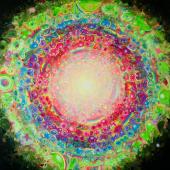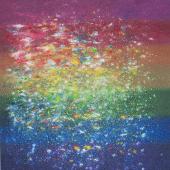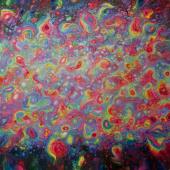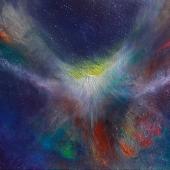Virtual exhibition The Great Awakening (September 11th, 2020)
Words from the catalog by the curator Laura Daranas Molina.
Five years ago, I wrote the following for the exhibition statement of Umbral, collateral to the 12th Havana Biennial: “The subjective experience of happiness is the fundamental theme in Alberto Lago’s work. […] His immediately recognizable style dwells in the frontier of abstraction and figuration, harmony and stridency. In his search for a way to translate certain states of consciousness onto the image, Lago has been influenced by artistic movements such as psychedelic art and American Bad Painting. Every so often, an area of shimmering void in his paintings seems to be pointing at (to paraphrase Huxley, a favorite of the artist’s) that which remains blocked by the limiting doors of our perception.”
Though not as curator this time but as spectator, I have the opportunity again to introduce his work. In retrospective, I see that as far as main motivations and liberal use of color go, Alberto Lago has been walking a very definite path all these years. However, along the way, his modes of expression have not ceased to change and each of his shows has brought us something we had not seen before. Thus, The great awakening reveals that his pop-style-inspired symbols now coexist with more “serene” paintings, where the absence of any kind of figuration encourages the appreciation of the whole. This pure abstraction arises as a seemingly organic development from his previous work.
No portraits, no nudes, barely a few of Lago’s signature happy faces and smiley hearts… this time at Maxima Gallery, color is the absolute protagonist. We had a first hint of this occurrence two years ago at Lloyd’s Register, when Lago introduced the rainbow leitmotiv. A few related paintings are included in The great awakening but presently the rainbow motif is taken further: beyond the scale of the optical phenomenon we’re familiar with, to reach the formidable magnitude of galaxies and the microscopic dimension of cells. As a consequence, the exhibition acquires metaphysical overtones, portraying the rainbow not only as ubiquitous (as it exists in potentiality wherever light reaches, even if it seldom manifests to our eyes) but also as an encompassing energy sustaining Creation.
Countless cultures around the globe thought the arch-in-the-sky (as the French call it) to be a bridge between the above and below: in Norse mythology it was the Bifröst bridge, uniting the realms of gods and men; in Santeria, it is Oshumare, the rainbow serpent, who takes back up to the sky the rainwater sent down to earth by Shango; in Japanese Shinto religion, the male and female gods of creation stood on a rainbow bridge to bring land to existence out of water. In Judeo-Christian tradition, God created the rainbow as a symbol of his covenant with Noah –a reminder of his promise to never wipe out life from the face of the Earth again by means of a deluge. Some scholars have taken the ark and the rainbow to represent two halves, an earthly inferior half and a heavenly superior half, uniting to form the egg whence life was reborn after the catastrophe.
Faced with the exhibition’s eponymous painting (a Big Bang, the bursting forth of the primordial egg) we’re prompted to contemplate the birth of Creation, whether in the Universe at large or within ourselves. Artists, of course, engage in creative acts constantly; hence the repeated metaphor of the demiurge who organizes the elements of the universe in ever new forms. The elements themselves, however, are not created by the artist, but rather share his/her nature since they stem from a common origin. This fundamental unity of all that exists (God? The universal consciousness? The Singularity? Light?) is the everlasting aim and theme in Lago’s work. To move toward that state of harmonious unity, toward the connection of human and divine, Lago chose a path which goes through an effervescent and diverse display of color and life.
By now, Lago occupies his own, unmistakable place in Cuban contemporary art. He works with admirable discipline, painting many hours each day, in a permanent journey of discovery into the depths of the medium. This journey he enjoys immensely, to judge from the enthusiasm with which he explores and shares every finding.
I hope the public will perceive this enthusiasm in his work and will enjoy Maxima Gallery and the artist’s invitation. In difficult times such as these, when we are confronted by fear of disease and scarcity, we are very much in need of everything that helps us remember that human beings are body but also spirit. Art in general, and Alberto Lago’s work in particular, have the potential to help us do that.
Laura Daranas Molina
Virtual exhibition The great awakening, by the artist Alberto Lago at's Maxima gallery.










